Table of Contents
Setting up a league
Here we are going to set up a brand new league and walk through what league organisers need to do to get themselves up and running. You will need to be logged on as a club, district or county.
Create a league
In the Leagues area, you will see a Create New League button which presents you with a screen like the following.
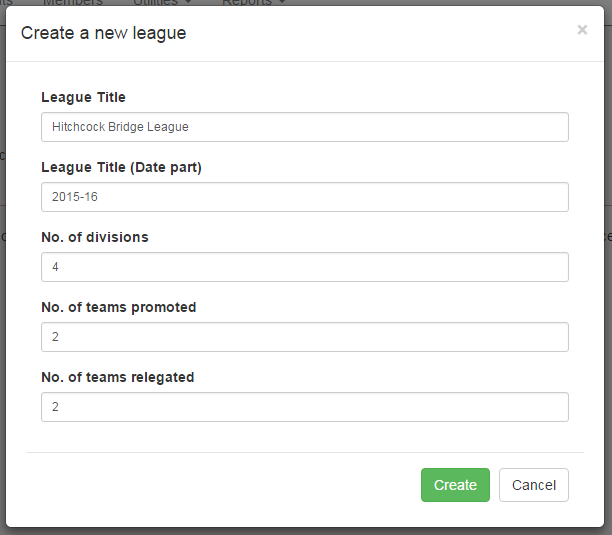
The League Title is split into two parts: the name of the league and the date. This makes it easier to group similar leagues together on the results pages.
The No. of divisions is the total number of divisions in your league, not necessarily the highest numbered division.
No. of teams promoted and No. of teams relegated is just the default setting. If it differs from division to division you can change this in the individual division settings. This is only used to highlight certain rows in the results pages, so don't worry too much if you have a more complicated scenario.
Press Create and your league will be set up. Note that you cannot delete a league but if you make a mistake or you just wish to test out the system and get rid of it afterwards then you can contact us and we'll remove it for you.
List of leagues
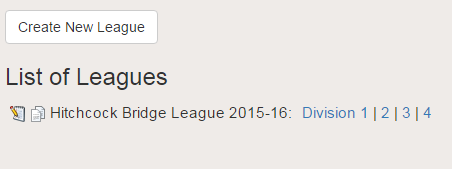
You will see all your leagues in the list of leagues, along with links to all the divisions that have been created. In addition, there are two icons by each league. The edit icon lets you rename the league if you made a mistake, or change some other settings. The copy icon lets you copy your league forward to a new year. You won't want to do this until the end of the season, though.
Amend league settings
Pressing on the Edit League icon in the list of leagues takes you to a settings page as follows:
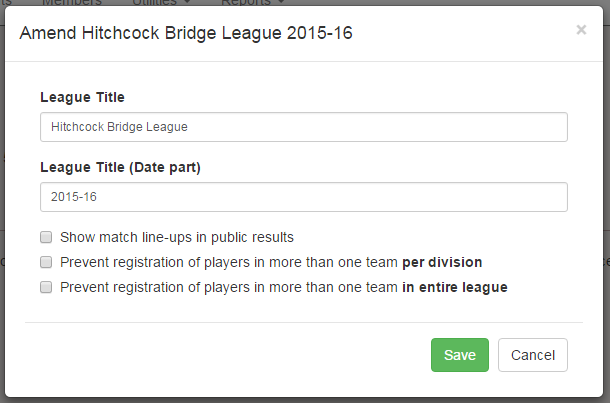
Here you can rename the league if you made a mistake, or change some other settings.
Show match line-ups in public results means that information about who played in each match will be available in the public results pages. The team roster can also be found by clicking on the team's name. We think this is a fun feature as it's a lot more interesting for people who didn't play to find out who won or lost a particular match, so we recommend that league organisers switch this on.
Prevent registration of players in more than one team per division and in entire league are options which kick in when a player gets added to a team, disallowing it if they are already part of another team in that division or in the whole league. Note that this only works during registration - it won't check affiliations retrospectively.
Divisions
Leagues are broken up into divisions and most of the work gets done at the division level. Even if your league only has one group of teams, it is still a one-division league and must be set up as such. To get to the division, just click on the link in the list of leagues. That brings you to a page like this:
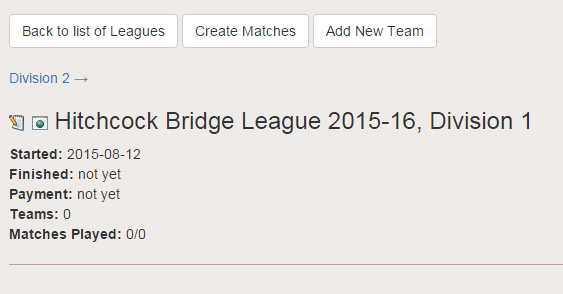
Here you will see some navigation and action buttons at the top, and information about the new division below. To edit the division settings you can click on the edit icon to the left of the division title. The web page icon next to it takes you to the public results page for this division. The edit page looks like this:
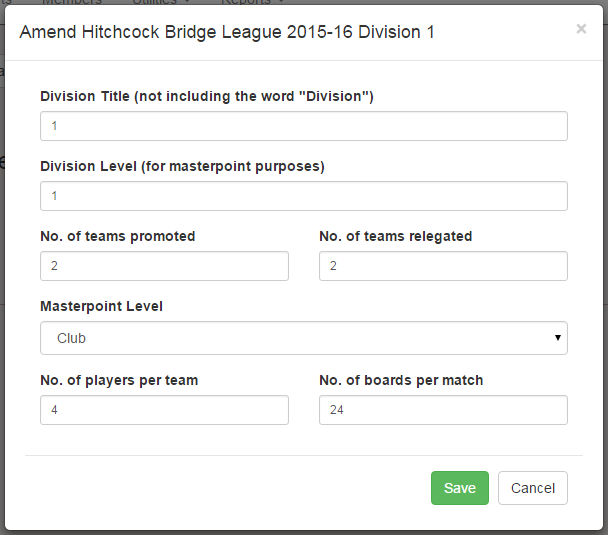
Division Title is the name of this division, not including the word Division. For example, if you're splitting your third tier into Division 3 North and Division 3 South then you can enter 3 North in the 3rd highest division and 3 South in the fourth highest division.
Division Level is used for the masterpoint calculation. In the previous example, the fourth highest division (Division 3 South) will default to being level 4, but it will need to changed to level 3. If you're not sure what to do here then you can contact our masterpoints department for assistance.
No. of teams promoted and No. of teams relegated were described above and can be amended here if the overall league setting isn't correct for this division.
Masterpoint Level tells us which masterpoint scale to use.
No. of players per team is the number of players who play in a particular match - not the number of players on the entire squad. For example, a teams-of-four league may allow squads of six people but you should still enter 4 in this field. This affects both masterpoints and payment at the end of the season.
No. of boards per match also affects the masterpoints calculation at the end of the season.
Add new team
To create a new team, click on the Add New Team button.
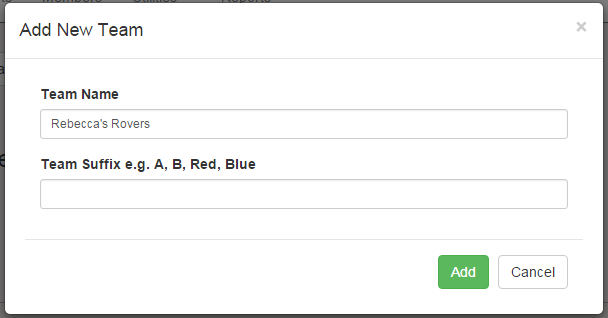
Simply fill out the team name and the team suffix. The latter is used to distinguish teams from the same club or county. For example, if the team was Aylesbury C then Aylesbury would be the name and C would be the suffix. Add the rest of your teams and your division will look a bit like this.
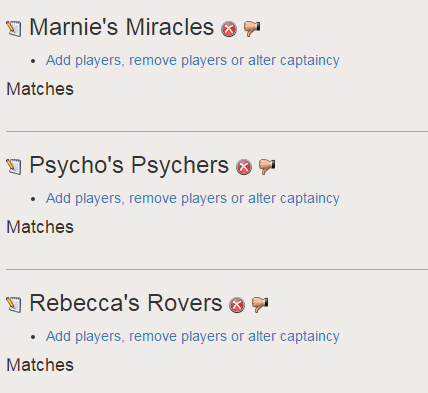
The edit icon will let you amend the team name if you made a mistake. An additional setting here is the ability to add a VP adjustment to the team, which is useful if you need to fine them for some reason. The other icons by the team title allow you to delete, promote or relegate this team. The latter two are more useful for next season, when you've copied the league and need to juggle the teams about between divisions, but if you create a team in the wrong division you can move them about with the thumbs up and thumbs down buttons.
Adding players to a team
Under each team you'll find a link to Add players, remove players or alter captaincy and clicking on it brings up a page like this:
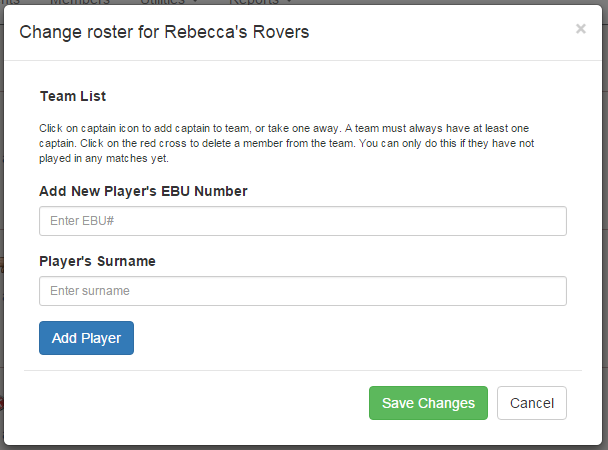
To add a new member to the team, enter their EBU number and surname into the two boxes and click Add Player. If you don't know the EBU number you'll have to ask them. The surname is required as an additional check, and to prevent you from getting the number wrong and registering someone completely unrelated to the team. Once you have some members in the team, it'll look this this:
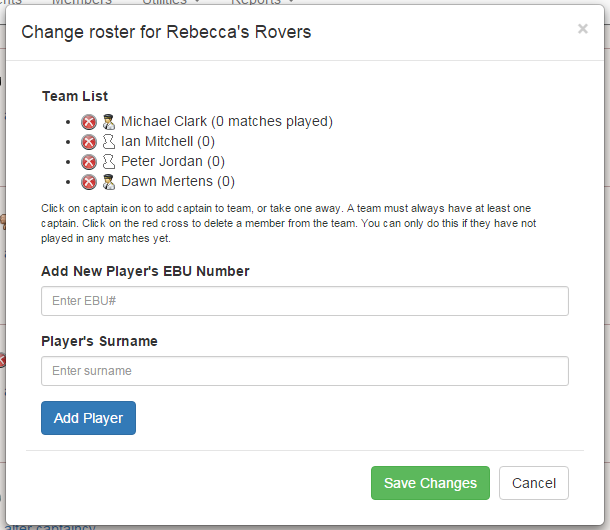
Here you can remove a player from the team by clicking on the red cross beside their name. Note that you can only do this if they have not participated in any matches - the icon will be greyed out if so.
The other icon by the player's name is whether or not they are a captain, and you can toggle this by clicking on it. When it is filled in they are a captain, and when it is just an outline they are not.
When you are done, press Save Changes. Note that you must always have at least one captain on the team, so the save button will complain if you get rid of all of them.
What does a captain do?
A captain has two abilities:
- They can amend the team roster, to add and remove players from their team.
- They can submit results on the team's behalf by entering the score, the date and who played on their team.
A captain cannot:
- Remove another captain (or themself) from the team.
- Make someone else a captain.
- Enter the players of the opposing team.
League organisers always have the same abilities as team captains, but the job of the league organiser becomes much simpler if they can delegate these jobs to their captains.
For more information on how the captaincy side of things works, see our help page for captains.
What about non-members?
First of all, it's not a big deal if you leave them off the team. The only reason to keep track of EBU numbers and who is playing in which match is for the purposes of masterpoints, which non-members have no interest in. If a division is declared as being for teams of four, and a team submits a result with just three players participating then the league will still be charged for four players. The only exception to this is if zero players play in both teams in a match - then the assumption is that the match was not played and an artificial score was awarded.
If league organisers nevertheless want to keep track of non-members, then here are some things to bear in mind.
- Many non-members of the EBU have an EBU number anyway. Perhaps they used to be members, they once bought something from the EBU shop, took part in a course, entered an event or they have been designated by a club as a potential member. So it's worth checking with them (or the EBU) even if they are not members.
- Clubs have the ability to create records for people but not join them to the club. They will initially be given a temporary EBU number, but if you wait 24 hours you should be able to find them with the search facility in the members area (follow the procedure as if you're looking for them to join them up to the club).
- Counties and districts will not be able to do this, but they may have a friendly local club who can oblige.
Create matches
Once all the teams have been entered onto the system, it is time to set up the matches. Important: once you have done this you will no longer be able to add new teams, remove teams, or promote/relegate teams to and from this division. So be sure that all the teams are present and correct before moving on. This doesn't affect the team personnel or team name, which you can change throughout the season.
When you press Create Matches you will be asked to enter the number of rounds i.e. is it a single, double, triple or quadruple round-robin. With 2 or 4 rounds, teams will be assigned home/away against every other team an even number of times. With 1 or 3 rounds, the odd round will be assigned randomly, although league organisers can change home/away for any particular match.
Once you've selected the number of rounds the team will look something like this:
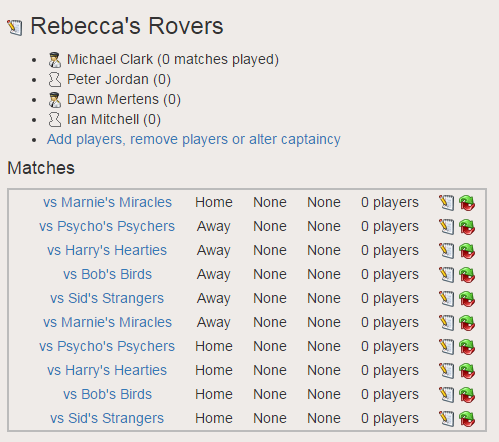
This example is a double round-robin, so Rebecca's Rovers are playing each of the other five teams twice, once home and once away. The double arrow icon will swap home/away around and the edit icon will let you amend this match (see next section).
Edit a match (submit results)
Clicking on the link or on the edit match icon will take you to a form where you can enter the result of the match. It will look like this:

This one should be self-explanatory. You enter the date, the score and then you check the boxes by every player who participated in the match. You then press Save and the match data will be recorded. You can always edit the match again later - nothing is set in stone until the end of the season.
One thing league organisers may sometimes wish to do is to set up all the match dates in advance, which you can do in the same way. The form doesn't require that you enter any results or players - you can just add the date and then hit Save.
